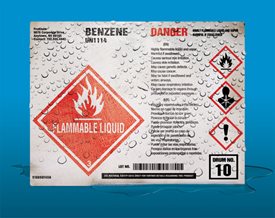Q: What is GHS?
Q: When was the GHS officially adopted?
Q: When was the deadline for the GHS phase-in dates?
Q: What are the performance requirements of a GHS-compliant label?
Q: What information is required on a GHS label?
Q: What printing technology can I use to print GHS labels?
Q: Can my label stock help avoid static build-up dangers?
Q: Why is BS 5609 compliance required?
Q: What are the employer responsibilities regarding GHS?
Q: Where can I find more information on GHS?
Q: What is GHS?
GHS is an acronym for The Globally Harmonized System of Classification and Labeling of Chemicals. It is a global system for harmonizing hazard classification criteria and chemical hazard communication elements. The GHS is not a global regulation; rather it is guidance for classifying and labeling chemicals and hazardous materials. The purpose the GHS is to provide unified information to users of chemicals with the goal of enhancing protection of human health and the environment.
Countries are not obligated to adopt all or even any part of the GHS; they can choose the elements they wish to regulate. Adopting countries have the sole responsibility to enforce GHS.
Q: When was the GHS officially adopted?
OSHA officially adopted these GHS requirements for chemical container labels when it revised their Hazard Communication Standard in 2012.
Q: When was the deadline for the GHS phase-in dates?
As of June 1, 2016, employers were required to update chemical container labels and hazard communication programs and provide employee training on the new label elements and safety data sheet (SDS) format.
Q: What are the performance requirements of a GHS-compliant label?
GHS labels must be extremely durable and stay affixed to the chemical drum or container without fading or becoming unreadable when exposed to harsh indoor or outdoor conditions, including exposure to chemicals, moisture and spills.
Q: What information is required on a GHS label?

- Product identifier: The name of the enclosed chemical
- Hazard pictograms: The hazard associated with the chemical
- Signal word: “Warning” or “Danger,” depending on the severity of the chemical hazard
- Hazard and precautionary statement: physical, health and/or environmental hazard
- First aid statement: Emergency care instructions for those exposed to the chemical
- Contact information for the supplier or responsible party
The printing method is dependent upon the type of substrate used. Because of PPG TESLIN® substrate’s unique
performance benefits, it can accommodate a wide range of high-temperature and digital color printing technologies, including laser, inkjet and thermal-transfer printing.
Q: Can my label stock help avoid static build-up dangers?
Many synthetic substrates are vulnerable to static build-up. The resulting electrical currents have the potential to shock or injure press operators or to spark fires in volatile chemical environments. The micropores in label stock made with
Teslin substrate naturally absorb and dissipate static, reducing the potential for electrical discharge. (
Teslin substrate passes
ESDS.541 at 50 percent relative humidity.)
Q: Why is BS 5609 compliance required?
BS 5609 certified labels are proven to meet the most stringent tests for durability in the industry, and are described as an extremely durable chemical container label suitable to use in harsh environmental conditions. The International Maritime Dangerous Goods (IMDG) certification requires all hazardous materials shipped via international waters to meet BS 5609 specifications for labeling, which means that labels be able to withstand exposure to water and sunlight.
Teslin labels are BS 5609 Sections 2 and 3 certified.
Q: What are the employer responsibilities regarding GHS?
Employers must maintain the container labels so that they are legible and the pertinent information is not affected by scraping, scuffing or abrasion. They are also responsible for relabeling containers if they become defaced.
Q: Where can I find more information on GHS?
For more information on GHS criteria, including labeling, refer to the
OSHA Hazard Communication page.